

The Chubb Archive is part of The History of Locks Museum Resources
Contact our curator for more information
© 2004 - 2016

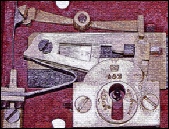
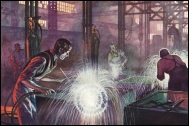
Your one-stop resource for dating & information on vintage and antique Chubb Locks, Safes & Security Equipment
Chatwood-Milner Ltd
A brief background to Chatwood and Milner History – 1956-1971
By Philip J. Pascoe
Chatwood: Samuel Chatwood, an industrialist greatly influenced by the ideas of Robert Owen and the co-operative movement strong in the mid 1800’s, began making safes in the late 1850’s at a factory in Bolton and subsequently moved to Shrewsbury (in 1926). Although control of the company passed to Hall and Pickles, the steel merchants, the Chatwood name survived until 1956. Chatwood claimed he was not merely another lock and safe maker, but a bankers’ engineer; consequently his company never produced domestic locks at all. In 1956, the formation of the Hall Engineering Group brought about the amalgamation of Chatwood and Milner (as Chatwood-Milner Ltd.) operating until 1958 when the company became a member of the Chubb group of companies.
Milners: Thomas Milner was a tinsmith who, having served his apprenticeship in his father’s factory, began making safes in Sheffield at the turn of the 19th century. In 1830 he moved to Liverpool and established Thomas Milner & Son in partnership with his son, William. In 1874, the name was changed to Milners Safe Company and continued with this name until the amalgamation with Chatwood in 1956. At one time Milners was considered the largest safe maker in the world.
Chatwood-Milner Ltd: Formed in 1956 when The Chatwood Safe and Engineering Co. Ltd., Shrewsbury, bought the ailing Milners Safe Co. Ltd., of Speke, Liverpool. Both were subsidiary companies of the Hall Engineering Holdings Group. I joined the company in 1959 and distinctly remember former Milners’ personnel referring to the union as a ‘merger’ whereas their Chatwood counterparts used the word ‘takeover’. It is also perhaps significant that Chatwood personnel held the more senior positions. Chatwood’s senior Drawing Office chief, a Mr. George Freeth, along with two other D.O. personnel were sent to Speke to look after Chatwood’s interests after the merger.
Both Chatwood and Milners were of similar size, making complimentary and roughly corresponding ranges of safes and strongroom doors at the time of the merger. Chatwood, following WW2, had diversified by making steel/glazed office and factory floor partitioning and, strangely, steel hospital lockers due mainly to their MD at the time, Mr. J.E Sixsmith, being chairman of the local hospital board. At the same time some surplus production capacity at Shrewsbury was given over to making automobile parts.
The same thing had been happening at the Milners factory in Speke, when, in 1960, production of all security equipment stopped as the factory was sold to the Standard Triumph Motor Co.
The newly formed company, Chatwood-Milner Ltd., utilized the former Milners’ London office, at 58, Holborn Viaduct, EC1 as its new Head Office and also used the Milners’ Service Department at 54/6, Compton Street, EC1, near the Smithfield meat market, to handle storage, safe repairs and forcing- opens plus deliveries of new equipment within the south east of England.
The company, unfortunately, did not flourish as was hoped and was eventually snapped up by the larger and rapidly expanding Chubb Group in 1958.
When I joined the company in October 1959 the following personnel were running the company:-
Sir James E.T. Ritchie, Chairman, formerly Chairman, Milners Safe. Co.Ltd.1
Mr. Leonard H. Dunham, D/Chairman. Then currently, Managing Director, Chubb & Son’s L&S Co.Ltd.
Mr. Harry Thorpe, Director and General Manager (formerly of Chatwood, Manchester)
Mr. George W. Frost. Advertising and Publicity Director. (formerly of Milners)
Mr. Charles A. Larke, Director, Chubb and Son’s.
Mr. Stuart H. Cornford, Director, Chubb & Son’s Lock and Safe Co., Ltd.
Mr. Ron Underwood, Company Secretary (formerly of Milners)
Mr. Alfred A. Evans, Accountant (unsure of his origin)
Mr. John Dewar, London Area Manager (formerly of Chatwood, Glasgow)
Mr. Kenneth H(ugh) Fletcher, Deputy London Manager/Special accounts ((formerly of Milners).
Mr. ‘George’ (H.A.) Schwaner, Southern Area Sales Manager (formerly of Chatwood)
Mr. A.L. ‘Dick’ Quann, Banks Division Manager (formerly of Chatwood)
Mr. W.D(on) Fairclough, Export Division Manager (formerly of Milners)
Mr. Tom Sandercoe. Deputy Export Manager, (formerly of Milners)
Mr. Sidney G. Hodgson, Service Department Manager, (formerly of Milners)
Mr. Samuel D. Nock, Administration Manager, (formerly of Chatwood, Shrewsbury)
Mr. Kenneth G. Catherall, Progress Manager, (formerly of Milners)
Mr. George A. Sexton, Senior Sales Representative, (formerly of Chatwood)
Branches were located at:
Bristol: Mr. Paul Best, Branch Manager; recently recruited.
Glasgow: Mr. E.T. Burr, Branch Manager, (formerly of Chatwood)
Manchester: Mr. James T(immis) Fletcher, Branch Manager, (formerly of Chatwood) and Leeds
Liverpool: Mr. D(oug) G.A Mears, (formerly of Milners)
Factories:
Shrewsbury: Mr. Frank Dixon (formerly Hall Engineering), was Managing Director, Hall
Engineering.
Mr. Allan Platt, (formerly Chatwood), security division manager
Speke: Mr. Frank Chisholm, works manager.
During 1959 it was decreed that certain Chubb range safes would be sold under the Chatwood-Milner brand name, these being the (Chubb) Commerce and the Standard ABP ranges, which had modified design hinges and painted in a single (drab, dark grey) colour to contrast with the smarter, more attractive two tone finish of the Chubb counterparts. The equivalent C-M safes were known as Duplex Drill-resisting and Duplex Anti-blowpipe respectively and were marketed in the same sizes and roughly similar prices. Following Chubb’s introduction of its new TDR (torch and drill resisting) range of safes in 1962, in three strengths, the same safes were made available for C-M to sell, named Duplextra, Mk 1 (equivalent 1st strength TDR), Mk.2 (equivalent 2nd strength TDR) & Mk.3, the equivalent of the Chubb 3rd strength TDR or Bankers safes).
Chatwood-Milner continued to supply the Milners’ Merlin light safes – Merlin being an anagram of Milner - to compete with the Stafford safes (made by Chubb) together with the slightly heavier Document Safes, a popular Milners design. For a time Merlin and Document safes continued in production at Speke but later, from about 1960 onwards, when all security equipment production ceased at Speke in favour of motor-car parts, manufacture was transferred to Shrewsbury. Also in the range were the eminently successful Chatwood Duplex Minor and Major safes, especially popular with the Co-operative movements. Former Chatwood Anti-blowpipe safes were also made at Shrewsbury and carried on for a number of years and also were made available to Chubb salesmen under the guise of ‘Totfield’ safes. Chatwood-Milner also supplied the heavy Treasury range of safes mainly taken by the Midland bank as cash storage safes within vaults.
Strongroom doors were being provided by the Speke factory in the main before certain Chubb doors were made available to Chatwood-Milner in corresponding sizes. Milners had developed a new 3.5”
anti-blowpipe Branch bank vault door which was the mainstay product of Chatwood-Milner since Shrewsbury 3½” door production had ceased about the time of the merger. The Speke C-M door
was a departure from normal practice having an attractive pressed steel frame instead of the usual angle iron grip frames that were popular with British safe manufacturers for several decades
However, once Chubb had bought out the company (in 1958), the Milners design doors were phased out and Chubb 3½” doors in the slightly modified C-M edition, were introduced and by mid 1960 a further decision was made to manufacture 3.5” doors for C-M at the former, then under-utilised, Hobbs-Hart factory at Staffa Road, Leyton, London, E.10.
During all this time the very popular and expanding market for bank vaults manufactured from factory made pre-cast, reinforced concrete blocks was pressing ahead. Chatwood, at their Shrewsbury plant, were making strongroom blocks in profusion and continued to do so under the Chatwood-Milner name. At the same time the market was also being supplied by Chubb who sub-contracted their block production and erection to a specialist banking contractor and builder, Wm. Nicholson & Son (Leeds) Ltd. Nicholson’s ‘Chubb’ blocks contained Chubb ‘Tangbar’ twisted anti-burglary reinforcement whereas the C-M blocks contained Chatwood’s patented, excellent Spiral Reinforcement, considered to be far superior. This expansion was as a result of the banks’ joint decisions to go to the people when they were opening branches in all sorts of places, on housing estates, in shopping malls - all in addition to their traditional positions in the High Streets of Britain.
Spiral Reinforcement mattresses, made at Shrewsbury since 1930, were still being supplied to banks at home and overseas during the whole time Chatwood-Milner was in existence, although production finally ceased in the 1990’s when prefabricated, de-mountable vaults made from complete panels increased over the very much more permanent PCB block designs. It is an established fact that the British Post Office authorities were still building their vaults of cast-in-situ concrete containing Chatwood designed Spiral mattresses well into the 1990’s. It is a testament to the quality of the product that it should have been specified for security purposes for well over sixty (60) years.
In the early 1960’s Chatwood-Milner decided to expand by opening a branch office in Birmingham (in Bradford Street) appointing a gentleman from the former Chatwood Safe Co. at Shrewsbury to the position, this being Mr. David P. Jones, formerly the manager selling steel office partitioning.
During 1966, probably commencing on April 1st, Mr. Harry Thorpe had moved on from being Managing Director of C-M Ltd., to become Deputy Managing Director of Chubb & Son’s Lock and Safe Co. Ltd., his place being taken over by the former manager of Chubb’s Wolverhampton lock division, Mr. Alfred L. Markham, later becoming M/Director of the Lock and Safe. Company itself.
Some time during 1967 Chatwood-Milner were forced to move their London Head Office due to anticipated development of the ageing Holborn Viaduct building. C-M moved to vacated office premises at 44/5, Chancery Lance, WC2, remaining there until the time of the dissolution in March 1971..
By this time, Mr. Dick Quann had retired; his position having been taken over by George Schwaner. ‘ably’ assisted by the writer for a couple of years. George Schwaner went on to become Bank’s Director and had recruited a gentleman from the Rio Tinto Company, a Mr. Dennis E. Crouch, to assist him with sales and administration. I recall that Mr.Don Fairclough was promoted to become general Sales Director, his former position of Export Manager having been given to a new recruit, a Mike Dempsey. When Mr. Alfred Markham went (back) to Chubb as Managing Director, C-M recruited a new M.D. from ‘outside’ – it was the flavour at the time for new, top appointments to be satisfied with ‘outsiders’ (to the industry) rather than recruiting from within – whence Mr. R. A. (Dick) Chapman joined the Company from the Gillette razor blade company.
I, personally, was appointed to the position of Contracts Supervisor on 12th December 1962, the morning after the tragic death in a motor car crash the night before of Mr. Leonard H. Roberts, a former Chatwood, Shrewsbury man who, only a year earlier, had been appointed to the position following the then rapid expansion of block strongroom building activity, referred to earlier. On the day of his death Len Roberts had been to Midland Bank in Bedford to take site dimensions for a yet another new strongroom, along with Mr. Tom Hall, who was Shrewsbury’s most experienced draughtsman. Mr. Hall survived the crash but, unfortunately, was never quite that same afterwards as his badly damaged and disfigured face had to be reconstructed without the aid of a photograph.
So, for the whole of the 1960’s, Chubb and Chatwood-Milner were surviving in the market place side by side, competing with each other but taking a significant market share from the likes of John Tann and Ratner plus newly emerging safe companies such as Stratford, SLS, SMP, etc.
During 1970 there had been a problem in the Manchester office involving the dismissal of a senior executive. Mr. David Jones from Birmingham was promoted to fill the void and Mr. Peter New, the then area sales representative covering Newcastle and the north east was promoted to take over the Birmingham branch.
Within a few weeks of these developments, in the spring of 1971, the then top management of the Chubb Group took the decision to merge the British Isles activity into just one company, Chubb, and discontinue the Chatwood-Milner name except for certain export markets where the name of Milner and Chatwood-Milner were very well known, especially in Africa and the Far East. At the same time Chubb decided to regionalize their overall sales and service operations into five distinct regions:
- South East : Manager appointed, John Dewar (formerly Chatwood/Chatwood-Milner)
- Midlands and South West: Regional Office, Birmingham, manager appointed - Mr. D.R.E. Ibbs previously Export Manager for Chubb Lock and Safe Company.
- Northern: Headquarters at Manchester (Salford actually), manager appointed, Mr. J. Stewart-Smith, a Chubb man.
- Scotland: Office located in Edinburgh and managed by Mr. Ian B. Radcliffe, previously
Chubb’s Service Department manager, Bromley-by-Bow and a lock marketing specialist.
- Ireland: Office located in Dublin; manager appointed Mr. E.N. (Ted) Hewitt, a Chubb man.
The then current staff were then shaken up and relocated. Many people decided to leave anyway but there were very few redundancies as such. The following C-M staff members were deployed in the new set-up as follows:-
London/south east areas:
Mr. Don Fairclough, (C-M Sales Director) became Export Manager for Chubb.
Mr. John Dewar, (C-M Home Sales manager) became Chubb Regional General Manager, S.E. Region
Mr. Dennis E. Crouch (C-M banks manager) became branch manager, Chubb St. James’s Street.
Mr. Brian Finch, (C-M rep. for southern home counties) became a rep for Chubb northern home counties branch which eventually operated from a rented house in Golders Green, NW London.
Mr. Norman A. Devonshire, (special accounts rep, C-M), became rep at Chubb, St. James Street branch.
Mr. Douglas G. Anderson, (C-M area sales rep. for City and West End areas), became Chubb rep. for City & West End.
Mr. Reginald E. King, area sales rep. for northern home counties, C-M, became an assistant manager in the Banking Division.
Other areas:
Mr. Matthew Muir, former manager of C-M, Glasgow became the same again for Chubb.
Mr. John A. Jackson, C-M area rep for east midlands became Chubb rep for similar, but smaller area.
Mr. Ron Johnson, Leeds C-M branch manager became Chubb area representative for Yorkshire.
Mr. John A. Whiting, Bristol C-M branch manager, became an area rep for Chubb, Bristol; branch.
Mr. Mike Coupe, C-M area rep for South Wales, became an area rep for Chubb, Bristol; branch
Mr. Peter New, C-M Birmingham branch manager became an area rep. for Chubb, Birmingham area.
Mr. Richard Clark, C-M Birmingham rep became an area rep. for Chubb, Birmingham central areas.
Yours truly moved to Birmingham to open and man a new Bank Division regional office.
*****************************
Philip J. Pascoe (25th November 2008)


Chatwood Escutcheon (above) and (below) a Milner Safe Plate reproduced by kind permission of Richard Hunt

Milner Fire Resisting Safe. Reproduced by kind permission of Rene Maas.
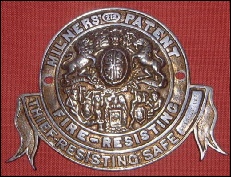
Milner Safe Plate
Reproduced by kind permission of Richard Hunt
Like many employers, Chatwood provided houses for some of their employees.
(Picture by kind permission of Tom Gordon)
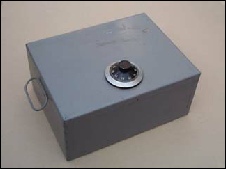

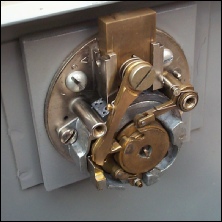
Document Box with Chatwood Milner Manifoil Mk3 Lock
Manifoil Mk3 Lock Body
Manifoil Mk3 Lock with cap removed showing lead shrouding to wheels, secondary & primary cams.
(Pictures by kind permission of ) See also note below ref: CM Manifoil Lock
Manifoil Keyless Combination Lock
Milners designed and produced the original Manifoil KC lock ; when Chatwood Milner became part of the Chubb Group, an improved Mk2 Manifoil Lock was being made at the Liverpool Factory. When it closed in 1960, production was transferred to the Chubb Lock Works in Wolverhampton and during the 1960’s the Mk3 version was introduced to meet MOD security requirements.
Towards the end of the 1960s, further security features were added resulting in the Mk4 Manifoil Lock, manufactured and supplied under contract to the MOD. By special agreement, it was made available to one or two overseas clients. Chubb continued to produce the Mk3 version for certain commercial clients.
(P.J. Gunn - Jan.2009)
Editor’s note:
The number ‘212‘, often seen on Milner’s brass safe plates, refers to the temperature (Fahrenheit) at which water boils. Insulation of the safe contents was provided by the proofing material in the body and door of the safe. This contained crystals that, when heated by the fire, emitted steam which was absorbed by the proofing mass.

Home | Previous Page | ToP | Next Page
| Chubb 1818-1990s |
| Chatwood-Milner |
| Chubb Family |
| Early Sales/Offices/ChubbGroup/1980s & on |
| The Detector Mechanism |
| Photographs |
| Chubb Money Boxes |
| The Aubin Trophy |
| Lock Number 696 |
| Williams acqusition |
| Arthur Briant |
| Ibbs - Export is Fun |
| Peter Gunn |
| Back to Work |
| First Steps |
| My Export Career begins |
| The Happy Years |
| Export Manager |
| Back to The Midlands |
| Back to The Midlands - part 2 |
| Australia |
| The Midlands - again! |
| The Final Years |
| Conclusions |
| Slingsby Dart T51 Sailplane |
| Latest News |